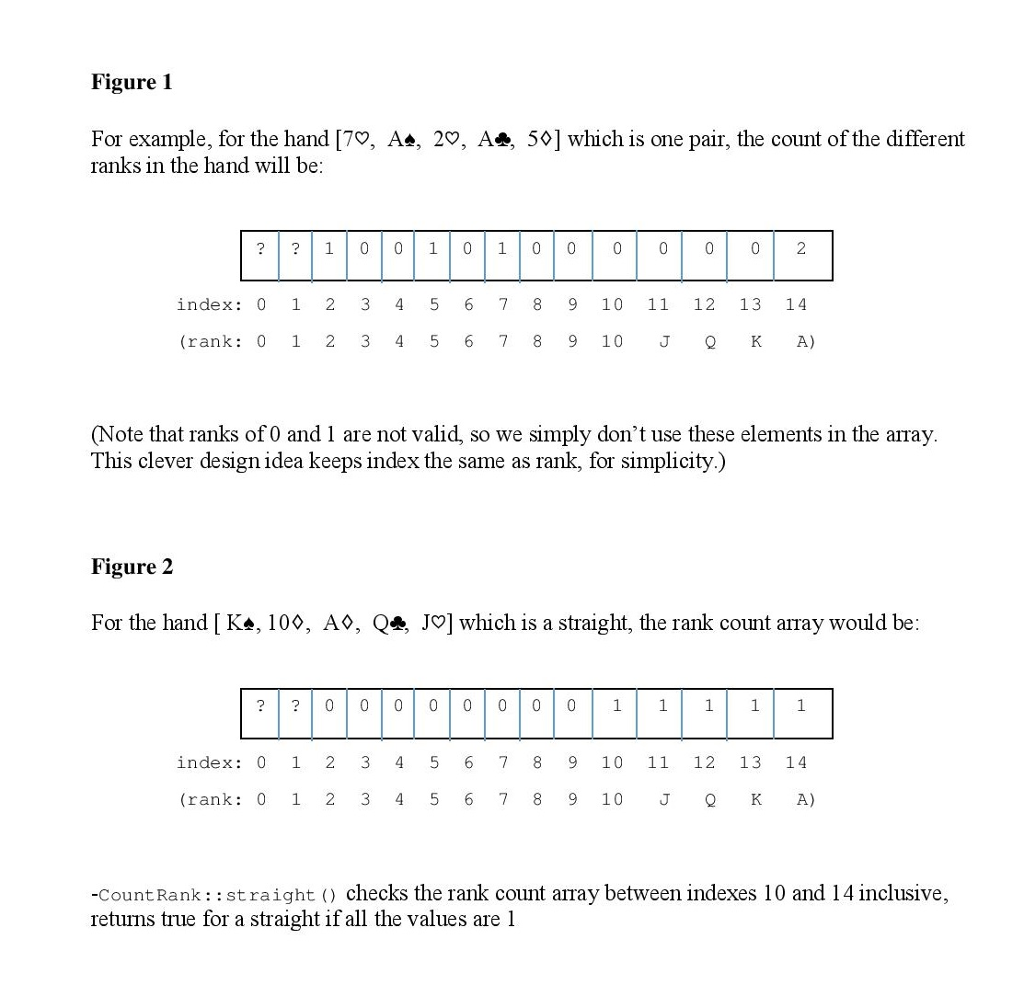Question
The purpose of this lab is for you to design and write many complex methods, working with arrays and array list objects in many classes.
The purpose of this lab is for you to design and write many complex methods, working with arrays and array list objects in many classes. A hand of 5 playing cards can be categorized as follows, from least to most valuable:
No pair The lowest hand. Five separate cards that do not make any of the hands below. One pair Two cards of the same rank, for example two Jacks. Two pair Two pairs, for example two 5s and two Kings. Three of a kind Three cards of the same rank, for example three 7s. Straight Five cards with consecutive ranks, not necessarily of the same suit, such as 7, 8, 9, 10, Jack. For now, Aces will always be high i.e. Aces rank above Kings, not below 2s. Flush Five cards all of the same suit, not necessarily in any order. Full House Three of a kind and a pair, for example three 9s and two 4s. Four of a kind Four cards of the same rank, for example four Aces. Straight Flush Five cards with consecutive ranks, all of the same suit. Is a straight and a flush Royal Flush The best possible hand. A 10, Jack, Queen, King, Ace, all of the same suit.
You will implement classes that categorize hands of cards.
The Tester class is given to you (BELOW) - creates many hands of cards and prints them out with categories labelled.
Constants - appropriate constants are required in all classes.
The Card class - Represents one single playing card. Aces will always be high i.e. Aces rank above Kings, not below 2s. No Jokers. Must be able to create a new card from a rank and suit. Need getter methods for rank and suit. toString() must nicely format a card.
The CountRank class - The idea of counting the ranks in a hand is used by the six categories concerned with rank only, so it will be implemented as a class named CountRank. The rank categories are: one pair, two pair, three of a kind, straight, full house, four of a kind. The CountRank class counts the ranks of cards in a hand. Use an integer array to do this, since the playing card ranks 2Ace are fixed and never change. For example, for the hand [7, A, 2, A, 5] which is one pair, the count of the different ranks in the hand will be: See Figure 1 below (Note that ranks of 0 and 1 are not valid, so we simply dont use these elements in the array. Keep index the same as rank, for simplicity.)
Required Exactly and only 1 instance variable: private int rankCount[];
The following class methods are required:
public CountRank(Hand h) - The constructor sets the counts in the rank array from a hand. A separate method is required in CountRank for each of the six rank categories, e.g.
public boolean fourOfAKind() - Returns true if any rank count is 4. and so on. Just one slight refinement here, that the straight() method must take two parameters:
public boolean straight(int min, int max) - Returns true if consecutive rank counts of 1, at indexes min thru max, inclusive. Hint: Hand::straight() must set min and max appropriately when calling this method e.g. for the hand [ K, 10, A, Q, J], which is a straight:
-Hand::straight() must find the minimum and maximum ranks in the hand. Here min would be 10 and max 14
-if necessary, Hand::straight() then calls CountRank::straight() with these params. The rank count array here would be: See Figure 2 below
-CountRank::straight() checks the rank count array between indexes 10 and 14 inclusive, returns true for a straight if all the values are 1
About toString()
Returns a string representation of the rank count array, nicely formatted. For example, printing the rank count array pictured immediately above would give:
{0, 0, 0, 0, 0, 0, 0, 0, 0, 0, 1, 1, 1, 1, 1} Should use StringBuilder as you build the big string from the array.
The Hand class - Represents a hand of 5 cards.A new hand in this lab always starts with five cards. A hand must be validated during creation, to check that it does not contain duplicate cards. Will still use an array list for hand. Important: you are not allowed to sort the hand!
Required Exactly and only 1 instance variable: private ArrayList cards;
The following class methods are required:
public Hand(Card first, Card second, Card third, Card fourth, Card fifth) - The constructor creates a full hand object from the 5 card objects seen in the method header given here. Must print an appropriate error message and exit the program if the hand contains any duplicate cards. (Hint: write a method in the hand class that uses a 2-dimensional array to validate a hand. The constructor calls this method.)
public Card getCard(int i) - Returns the card at index i from a hand. (Note: does not remove the card from the hand.)
public int category() - Returns the category of a hand. Important: is required to call a separate method in Hand for each of the ten hand categories as it does this i.e.
public int category()
{ int category = NO_PAIR;
if (royalFlush())
category = ROYAL_FLUSH;
else if (straightFlush())
category = STRAIGHT_FLUSH;
else if (fourOfAKind())
category = FOUR_OF_A_KIND;
. . . return category;}
So a separate method is required in Hand for each of the ten hand categories, e.g.
public boolean royalFlush() - Returns true if this hand is a royal flush. Then the six rank category methods in Hand are required to call the equivalent method in the RankCount class e.g.
public boolean onePair() - Returns true if this hand has exactly one pair. Required to call the CountRank::onePair() method as it does this. Heres the Hand method:
public boolean onePair()
{ CountRank cr = new CountRank(this);
// check cr for exactly one pair
return cr.onePair(); }
Some additional private helper methods will be useful.
private boolean hasAce() - Returns true if hand contains at least one Ace.
private boolean findRank(int rank) - Returns true if the rank is in the hand. You may add any other methods that you find useful.
About toString()
No special formatting required, so simply:
public String toString()
{ return cards.toString();}
Extra credit - have your program work with Aces low or high. Surprisingly, only two methods need to be changed! Some major hints:
-first, the key insight is to continue to represent all Aces internally as value 14/ACE_HIGH
-in the card class constructor, now allow the rank parameter coming in to the method to have the new value 1/ACE_LOW. Do this by simply changing this value to 14/ACE_HIGH before using it to set the rank instance variable
-in Hand::straight(), first set min and max from the hand as usual. Then changes are required, to handle the new special case of having a 2 and an Ace. (Here, min would be 2 and max 14.) Given Ace, 2, we now have to check for the rest of an Aces low straight, Ace, 2, 3, 4, 5. Theres a clever way to do this by updating min and max here. Then can call CountRank::straight() as usual
GIVEN TESTER CLASS
public class Tester { public static void main(String[] args) { // No pair System.out.println("No pair"); Hand noPair1 = new Hand(new Card(10, 3), new Card(3, 0), new Card(13, 2), new Card(5, 1), new Card(14, 3)); System.out.print(noPair1.toString()); System.out.print(printCategory(noPair1.category())); System.out.println(" ");
// One pair
System.out.println("One pair"); Hand onePair1 = new Hand(new Card(7, 2), new Card(14, 3), new Card(2, 2), new Card(14, 0), new Card(5, 1)); System.out.print(onePair1.toString()); System.out.print(printCategory(onePair1.category())); System.out.println(" ");
// Two pair System.out.println("Two pair"); Hand twoPair1 = new Hand(new Card(12, 0), new Card(3, 0), new Card(14, 3), new Card(14, 1), new Card(3, 2)); System.out.print(twoPair1.toString()); System.out.print(printCategory(twoPair1.category())); System.out.println(" ");
// Three of a kind System.out.println("Three of a kind"); Hand threeOfAKind1 = new Hand(new Card(14, 3), new Card(14, 0), new Card(6, 2), new Card(2, 2), new Card(14, 1)); System.out.print(threeOfAKind1.toString()); System.out.print(printCategory(threeOfAKind1.category())); System.out.println(" ");
// Straight System.out.println("Straight"); Hand straight1 = new Hand(new Card(13, 3), new Card(10, 1), new Card(14, 1), new Card(12, 0), new Card(11, 2)); System.out.print(straight1.toString()); System.out.print(printCategory(straight1.category())); System.out.println(); // aces low System.out.println("Extra credit - aces low"); Hand straight2 = new Hand(new Card(4, 3), new Card(3, 1), new Card(5, 1), new Card(2, 0), new Card(14, 2)); System.out.print(straight2.toString()); System.out.print(printCategory(straight2.category())); System.out.println(" ");
// Flush
System.out.println("Flush"); Hand flush1 = new Hand(new Card(8, 2), new Card(3, 2), new Card(11, 2), new Card(5, 2), new Card(14, 2)); System.out.print(flush1.toString()); System.out.print(printCategory(flush1.category())); System.out.println(" ");
// Full house System.out.println("Full house"); Hand fullHouse1 = new Hand(new Card(14, 3), new Card(9, 0), new Card(14, 0), new Card(14, 1), new Card(9, 3)); System.out.print(fullHouse1.toString()); System.out.print(printCategory(fullHouse1.category())); System.out.println(" ");
// Four of a kind System.out.println("Four of a kind"); Hand fourOfAKind1 = new Hand(new Card(14, 3), new Card(9, 3), new Card(14, 1), new Card(14, 2), new Card(14, 0)); System.out.print(fourOfAKind1.toString()); System.out.print(printCategory(fourOfAKind1.category())); System.out.println(" ");
// Straight flush System.out.println("Straight flush"); // (an aces high straight flush is a royal flush) Hand straightFlush1 = new Hand(new Card(5, 1), new Card(2, 1), new Card(4, 1), new Card(6, 1), new Card(3, 1)); System.out.print(straightFlush1.toString()); System.out.print(printCategory(straightFlush1.category())); System.out.println(); // aces low System.out.println("Extra credit - aces low"); Hand straightFlush2 = new Hand(new Card(4, 3), new Card(3, 3), new Card(14, 3), new Card(5, 3), new Card(2, 3)); System.out.print(straightFlush2.toString()); System.out.print(printCategory(straightFlush2.category())); System.out.println(" ");
// Royal flush System.out.println("Royal flush"); Hand royalFlush1 = new Hand(new Card(13, 0), new Card(10, 0), new Card(14, 0), new Card(11, 0), new Card(12, 0)); System.out.print(royalFlush1.toString()); System.out.print(printCategory(royalFlush1.category())); System.out.println(" ");
// Invalid hand System.out.println("Invalid hand"); Hand invalidHand1 = new Hand(new Card(13, 0), new Card(7, 2), new Card(2, 3), new Card(10, 1), new Card(13, 0)); System.out.print(invalidHand1.toString()); System.out.println(" "); }
/** * Returns the category of a hand. * * @param category int category of a hand * @return the category as a String */ public static String printCategory(int category) { String out = "";
switch (category) { case Hand.ROYAL_FLUSH : out = " Royal flush"; break; case Hand.STRAIGHT_FLUSH : out = " Straight flush"; break; case Hand.FOUR_OF_A_KIND : out = " Four of a kind"; break; case Hand.FULL_HOUSE : out = " Full house"; break; case Hand.FLUSH : out = " Flush"; break; case Hand.STRAIGHT : out = " Straight"; break; case Hand.THREE_OF_A_KIND : out = " Three of a kind"; break; case Hand.TWO_PAIR : out = " Two pair"; break; case Hand.ONE_PAIR : out = " One pair"; break; } return out;}}

Step by Step Solution
There are 3 Steps involved in it
Step: 1

Get Instant Access to Expert-Tailored Solutions
See step-by-step solutions with expert insights and AI powered tools for academic success
Step: 2

Step: 3

Ace Your Homework with AI
Get the answers you need in no time with our AI-driven, step-by-step assistance
Get Started


